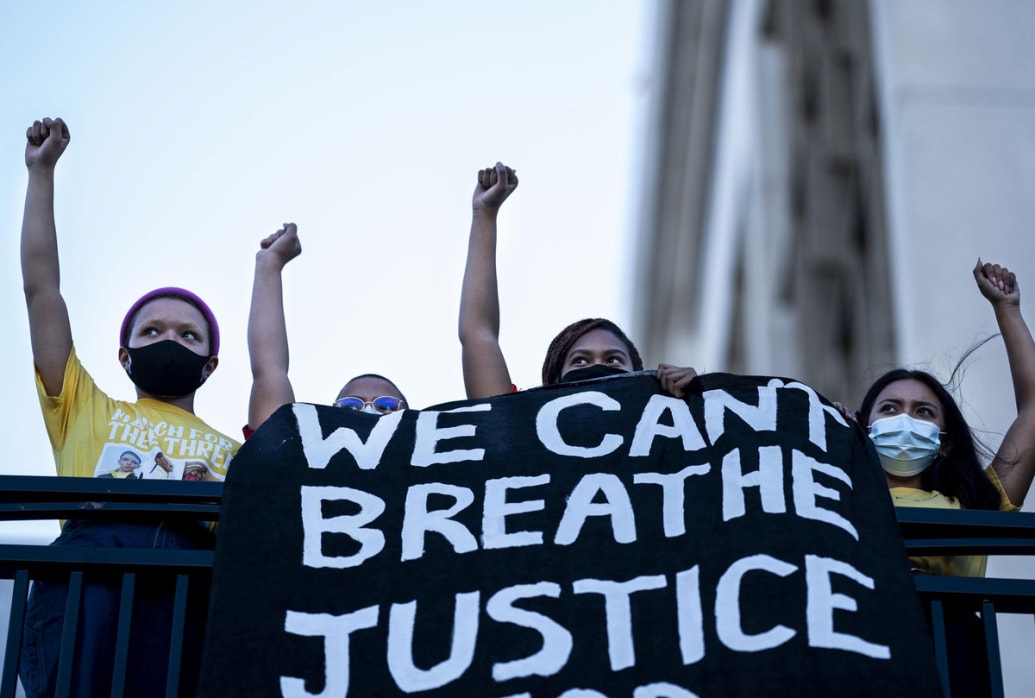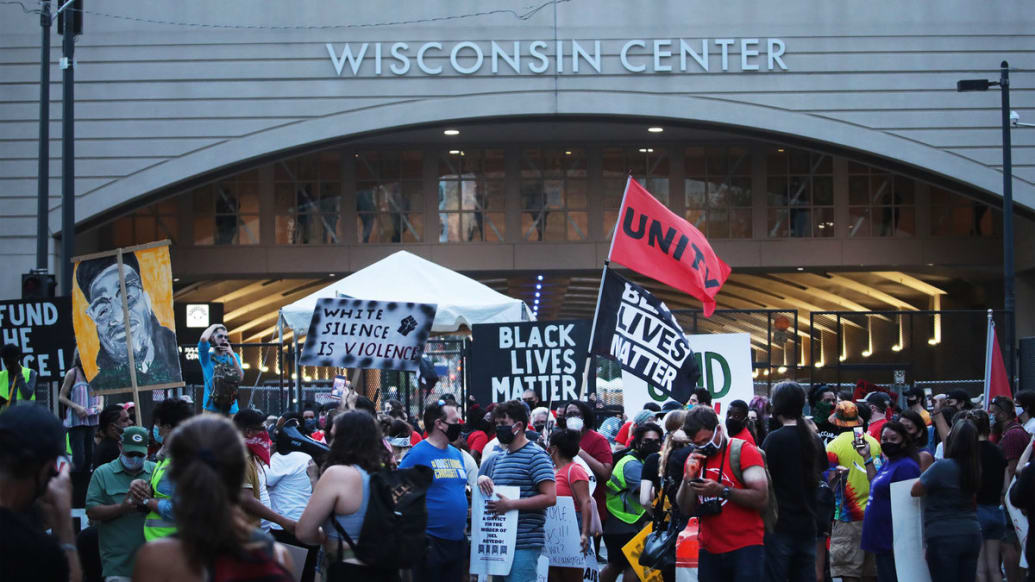Tari Davis was at home in Milwaukee watching a movie with his two children just after midnight when he heard the sirens.
It was Sept. 8, 2019, and the sound was not exactly foreign in the 43-year-old Black man’s neighborhood. Still, he grew concerned when the wailing kept getting closer, and more so when he got a phone call from his 19-year-old daughter’s fiancee, Kevin Brown.
According to Davis, Brown didn’t say anything on the phone, but the father soon came to realize the 22-year-old was the one being chased by police after his daughter spotted Brown’s car driving by their house—with a Milwaukee PD patrol car right behind it.
Davis told The Daily Beast he gathered his family at home, and was near his backdoor when it happened: A Milwaukee police officer fired a shot that hit Davis in the stomach.
He fell to the ground bleeding, he said, adding that to this day he was undergoing physical therapy, and he and his daughters were also seeing mental-health counselors for their trauma. In the aftermath of the shooting, Davis added, he and his family were treated like criminals, with cops searching his home.
He was never charged with a crime.

At the time of the incident, the Milwaukee Police Department was led by Alfonso Morales, a brash “cop’s cop” some residents, activists, and local officials say put an almost Donald Trump-style emphasis on law-and-order above community relations. Among other highlights, he notoriously compared criticism of cops during George Floyd protests last summer to the crucifixion of Jesus.
In what seemed like a nod to the times, Morales was demoted in August 2020, retiring soon after even as he submitted an appeal of the decision.
Like others in the city, Davis was stunned when, last December, a Milwaukee County Circuit judge ordered Morales be reinstated as chief, or else compensated because his ouster did not follow due process. Since then Morales, the city, and the police department have been in a dance over the possible return of a Top Cop seen as hostile to reform.
“We have a very bad situation of our own making,” Alderman Robert Bauman told The Daily Beast.
Like their counterparts in many other cities, when police protests exploded last year, Milwaukee cops used chemical munitions on citizens and carried out a number of questionable arrests.
But when anger at the police reached a boiling point, Milwaukee officials took action.
Do you know something we should about police or protests over police violence?
Email Andrew.Boryga@thedailybeast.com or reach him securely via Signal at 978-464-1291.
Morales was pushed out soon after he got his new marching orders, with the Commission demoting him—he later quit rather than accept the demotion—for what the body described as his failing to honor their calls for change.
Davis was just fine with that. “I was like, okay, that’s what you get,” he told The Daily Beast.
But Morales appealed the demotion, and Judge Christopher Foley ruled the city conducted a “flawed” process because they did not present Morales with any specific charges, present evidence, or allow him to challenge any evidence as part of swift proceedings on Aug. 6, 2020.
“I think the direction we’re going in is one that is quite positive. [Morales’] return would be disruptive to that.”
— Fred Royal, a vice-president of the local NAACP chapter
In May, frustrated by the lack of progress on a resolution to the episode, Foley gave the city an ultimatum: pay Morales to leave “for the sake of the City” or give him his job back by July 3, a deadline since extended to July 12. Despite ongoing negotiations, in which Morales’ price tag to walk reached the $1 million range, according to city leaders with knowledge of the discussions who spoke to The Daily Beast, a deal had yet to be struck by Thursday.
Morales did not respond to a request for comment for this story. His attorney, Franklyn Gimbel, did not respond to a request for comment, but told the Milwaukee Journal Sentinel Thursday that he was “guardedly optimistic” a settlement would be reached.
If there is no deal and Morales were to come back, leaders in some communities were worried about a regression toward harsh policing.
“I think the direction we’re going in is one that is quite positive. [Morales’] return would be disruptive to that,” Fred Royal, a vice-president of the local NAACP chapter, told The Daily Beast.
Like other local leaders, Royal praised acting Chief Jeffrey Norman, even as he seemed resigned to the man’s eventual departure. The acting chief, who is Black, was a top candidate for a job in a nearby department as recently as Thursday, though he was not chosen in the end, and remained in charge in Milwaukee.
Norman declined an interview request for this story. Milwaukee Police Department spokesman Efrain Cornejo declined to take a position on Morales’ ouster or possible return.
If some officials and community leaders were spooked about how the situation might play out, more radical voices—in keeping with a year marked by calls to Defund the Police—saw things differently.
“Whoever is in that police chief role doesn’t change the amount of money that is being allocated to the police department. Whoever the police chief is isn’t going to change the militarization of the police department,” Dwight Williamson, a project coordinator for Black Lives Matter Milwaukee, told The Daily Beast. “When it comes to who’s in charge, all that stuff is just talking points and a distraction.”
Rather than transformational policies, however, Morales’ ouster was tied to some nuts and bolts issues in policing.
Among the directives issued to him, according to the Milwaukee Journal Sentinel, was a request for details about the high-profile arrest and tasing of NBA player Sterling Brown in 2018 over an alleged parking violation. City leaders also wanted a public accounting of why tear gas and pepper spray were used during protests last summer.
The directives, first presented to Morales on July 21, 2020, had a tight deadline of just a week in many cases.
In an Aug. 4, 2020, video released by the police department to explain their protest response, Morales spoke briefly on camera to say that “a peaceful civil disturbance does not exist.” He said there had been 100 protests in Milwaukee in recent months, and six instances when the police department used tear gas and pepper spray to disperse crowds as a result of citizens’ “engaging in riotous behavior.”

Melina Mara/The Washington Post/Getty
Although Morales claimed to have attempted to make progress on other directives, in a lawsuit he later filed against the Fire and Police Commission and the city, he criticized them for not involving him in the process of creating the directives in the first place.
“Directives should not be made in a ‘spontaneous or willy-nilly fashion’ without the benefit of supporting evidence,” a report issued by the police department in August in response to the directives read.
In the midst of all the wrangling, some local leaders turned on each other even as they expressed anxiety about the future of policing in the city.
Bauman pointed specifically at the Fire and Police Commission, which he said hired Morales with “great fanfare” initially, but bungled the process of getting rid of him by not following the proper procedure.
“They clearly screwed up,” he said.
Nelson Soler, the chair of the commission, declined to comment about the circumstances surrounding Morales’ demotion, citing the “pending legal matter.”
If there were process issues, Bauman also said Morales’ comments at key moments during a national uprising over racism by cops inflamed tensions. He pointed specifically at the June 2020 press conference in which the chief made the analogy to Jesus Christ’s crucifixion in the face of protest anger.
“Everybody kind of said, ‘Is this guy well? Is he firing on all cylinders?’”
— Alderman Robert Bauman
“Two thousand years ago, an angry mob came before people to say, ‘Crucify that man.’ That man being Jesus Christ,” Morales said. When asked who he was saying was being crucified today, he clarified: “law enforcement throughout our nation. Law enforcement is being crucified.”
“Everybody kind of said, ‘Is this guy well? Is he firing on all cylinders?’” Bauman said.
Royal, of the NAACP, said Morales’ comments during the period of unrest and his unwillingness to meet and hear out protesters created an “us against them” mentality.

Scott Olson/Getty
It was a low point after some locals had high hopes for the chief in a city that had long been described as a hotbed of racial profiling by everyone from the ACLU to the Department of Justice.
Royal said that in early conversations with community leaders, Morales painted himself as someone who would change course, increase transparency and accountability, and improve community relations. “But once he put on those bars, he reversed that position,” Royal said.
If some Milwaukee residents were fearful of the man’s return, he has his admirers in a typical bulwark of pro-cop sentiment: the local police union.
Dale Bormann, president of the Milwaukee Police Association, said Morales’ tough tone may not have earned him many friends among city leaders, but did win him the support of most of the 1,400 officers represented by his union. He called Morales a “cop’s cop” and said he believes that many of the nearly 1,700 officers on the force would be happy to have him back.
“Chief Morales is not a politician chief,” Bormann told The Daily Beast. “He does things for his officers and he does things to also protect the citizens of Milwaukee.”
Bormann went so far as to say city leadership were “deathly afraid” of what might happen if Morales returned, placing the ex-chief’s style in direct contrast to that of Norman, the acting chief.
“He is trying to please people or please groups,” Bormann said of Norman, adding that that isn’t necessarily bad. “But I think he’s trying to please too many people at once, and I think maybe it’s to the point that now everybody is demanding everything. That’s not always good either.”
Milwaukee Mayor Tom Barrett declined to comment for this story, citing “the ongoing legal issues” through his spokesman Jeff Fleming. Fleming said Barrett had previously expressed his feelings that the Fire and Police Commission “mishandled” the way Morales was demoted.
Bormann, the union official, conceded that last summer’s protests “probably” played a role in Morales’ ouster, but said the chief’s handling of the situation was celebrated in some corners. “The difference between Milwaukee and a city like Seattle or Portland is that our city did not burn,” he said.
Regardless of how the botched demotion went down, Bormann said, the pending resolution likely won’t make anyone particularly happy. Even if the city offers Morales the money he wants, Bormann noted, it wasn’t clear how long Norman would stick around.
But that leaves an outstanding question for residents and officers alike: who will lead their department?
Royal, the NAACP leader, said paying Morales to go away would be well worth it, even if it produced some uncertainty as to future leadership. He pointed to the millions the police department has paid out in settlements over the previous years—and the millions more it might owe in the future.
“We need to hurry up and make a decision,” he said. “If we don’t change the mentality and the culture within MPD, we’ll continue to go down this path.”
As for Davis, despite such a violent experience with cops under Morales, he had mixed feelings about the potential change in power. He said he doesn’t think much has changed in Morales’ absence. “It’s still being managed the same way,” he said of the police department.
“The police department is just reckless. In my neighborhood, they don’t deal with public safety the same way they do in the suburbs.”
— Tari Davis
Police department disciplinary records obtained by The Daily Beast show that the officer who fired at him, Nikolas Zens, did so mistakenly after a nearly 14-mile pursuit of Brown evolved into a foot chase in the night. After Brown attempted to enter the backdoor of Davis’ house, police say, he turned toward Zens, who believed Brown had a gun and shot without aiming, hitting Davis. No gun was ever recovered from Brown, who could not immediately be reached for comment for this story.
As a result of the shooting, Zens was fired from the police department on July 30, 2020, according to the records. He declined to comment for this story.
Davis said he never heard from police about the shooting and only found out about the officer’s firing—and learned his identity—through the course of a lawsuit he filed against the department in 2019. He also said he never received an apology. Milwaukee Police Department spokesman Efrain Cornejo told The Daily Beast that a community briefing about what happened to Davis was never released because of the pending litigation he has against them, and declined to comment on his claims for that same reason.
Davis argued the idea that his daughter’s fiancee had a gun was a fabrication from police to justify the shooting, which he said would have never happened in other neighborhoods.
“The police department is just reckless,” he told The Daily Beast. “In my neighborhood, they don’t deal with public safety the same way they do in the suburbs.”
But even with his personal experience with a Morales-led department, Davis couldn’t help but feel like a settlement with the ex-chief would amount to a loss for victims of police violence.
“I don’t understand how he gets paid and I’m sitting here,” he said.
"bitter" - Google News
July 02, 2021 at 07:00AM
https://ift.tt/3h92ieR
How a Bitter Ex-Police Chief Could Plunge Milwaukee Into Chaos - Daily Beast
"bitter" - Google News
https://ift.tt/3bZFysT
https://ift.tt/2KSpWvj
Bagikan Berita Ini














0 Response to "How a Bitter Ex-Police Chief Could Plunge Milwaukee Into Chaos - Daily Beast"
Post a Comment